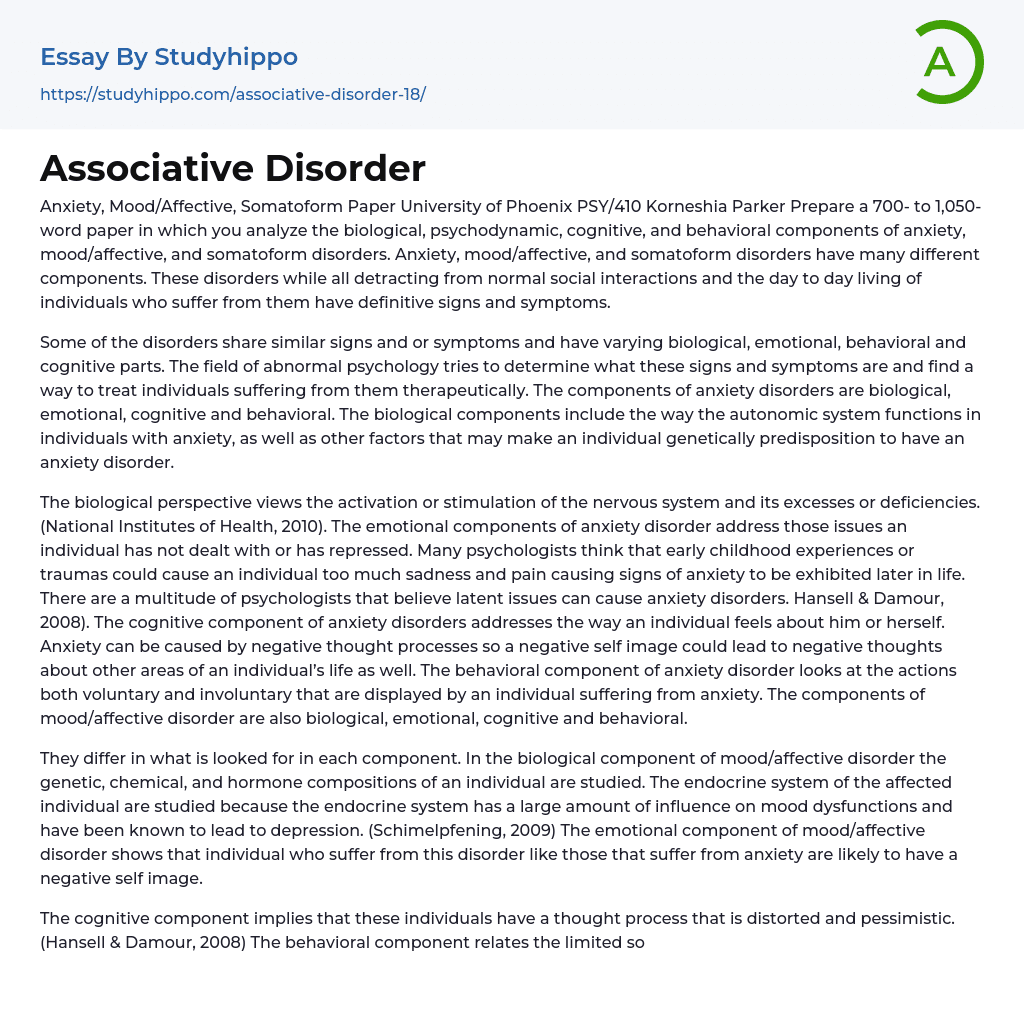Anxiety, Mood/Affective, Somatoform Paper University of Phoenix PSY/410 Korneshia Parker Prepare a 700- to 1,050-word paper in which you analyze the biological, psychodynamic, cognitive, and behavioral components of anxiety, mood/affective, and somatoform disorders. Anxiety, mood/affective, and somatoform disorders have many different components. These disorders while all detracting from normal social interactions and the day to day living of individuals who suffer from them have definitive signs and symptoms.
Some of the disorders share similar signs and or symptoms and have varying biological, emotional, behavioral and cognitive parts. The field of abnormal psychology tries to determine what these signs and symptoms are and find a way to treat individuals suffering from them therapeutically. The components of anxiety disorders are biological, emotional, cognitive and behavioral. The biological components include the way the autonomic syst
...em functions in individuals with anxiety, as well as other factors that may make an individual genetically predisposition to have an anxiety disorder.
The biological perspective views the activation or stimulation of the nervous system and its excesses or deficiencies. (National Institutes of Health, 2010). The emotional components of anxiety disorder address those issues an individual has not dealt with or has repressed. Many psychologists think that early childhood experiences or traumas could cause an individual too much sadness and pain causing signs of anxiety to be exhibited later in life. There are a multitude of psychologists that believe latent issues can cause anxiety disorders. Hansell & Damour, 2008). The cognitive component of anxiety disorders addresses the way an individual feels about him or herself. Anxiety can be caused by negative thought processes so a negative self image could lead to negative thoughts about other area
of an individual’s life as well. The behavioral component of anxiety disorder looks at the actions both voluntary and involuntary that are displayed by an individual suffering from anxiety. The components of mood/affective disorder are also biological, emotional, cognitive and behavioral.
They differ in what is looked for in each component. In the biological component of mood/affective disorder the genetic, chemical, and hormone compositions of an individual are studied. The endocrine system of the affected individual are studied because the endocrine system has a large amount of influence on mood dysfunctions and have been known to lead to depression. (Schimelpfening, 2009) The emotional component of mood/affective disorder shows that individual who suffer from this disorder like those that suffer from anxiety are likely to have a negative self image.
The cognitive component implies that these individuals have a thought process that is distorted and pessimistic. (Hansell & Damour, 2008) The behavioral component relates the limited social skills and other factors that can contribute to the depression suffered by individuals with mood/affective disorder causing them to fall into a cycle of negative thoughts and behaviors. (Hansell & Damour, 2008) Dissociative/Somatoform disorders have the same components as mood/affective disorders and anxiety disorders, the way these components affect individuals suffering from dissociative/somatoform disorders differs.
Individuals that suffer from dissociative and somatoform disorders are more likely to have members of their family that also suffer from this disorder. This fact has led researchers to conclude that this may be a genetic disorder. Severe trauma has been discovered as being a leading contributor to the emotional component of this disorder. Cognitively individuals that suffer from dissociative/somatoform disorders symptoms include: memory loss, detachment, and
a distorted perception of their surroundings.
Severe physical trauma, abuse and pain has an effect on behavior and the way an individual lives, they also have a negative effect on an individual’s ability to function normally. ( Hansell & Damour, 2008) Though these disorders have varied biological components as well as emotional, cognitive and behavioral components they do share some characteristics. Research has allowed many answers to be discovered in order to treat individuals suffering from these disorders. No one has discovered all the answers and due to the uniqueness of people a definitive conclusion ay never be reached, but by studying the components of these disorders a better understanding can be discovered. Understanding these disorders can help researchers find effective ways of treating disorders and help those individual’s that suffer from them. Dealing with traumatic issues effectively seems to be a common thread in treating associative, mood/affective and dissociative/somatoform disorders. References Hansell & Damour (2008) Abnormal Psychology National Institute of Health (2010) Phobias Schimelpening, N. (2007) Bipolar Disorder- definitive of bipolar disorder
- Emergence essays
- Anxiety Disorder essays
- Post-traumatic Stress Disorder essays
- Academia essays
- Higher Education essays
- Language Learning essays
- Studying Business essays
- Education System essays
- Study essays
- First Day of School essays
- Scholarship essays
- Pedagogy essays
- Curriculum essays
- Coursework essays
- Studying Abroad essays
- Philosophy of Education essays
- Purpose of Education essays
- Brainstorming essays
- Educational Goals essays
- Importance Of College Education essays
- Brown V Board of Education essays
- The Importance Of Higher Education essays
- Online Education Vs Traditional Education essays
- Academic And Career Goals essays
- Academic Integrity essays
- Brown Vs Board Of Education essays
- Distance learning essays
- Technology in Education essays
- Vocabulary essays
- Writing Experience essays
- Importance of Education essays
- Early Childhood Education essays
- Academic Degree essays
- Academic Dishonesty essays
- School Uniform essays
- Academic writing essays
- Cheating essays
- Bachelor's Degree essays
- MBA essays
- College Life essays
- Grade essays
- Diploma essays
- Phonology essays
- Sentence essays
- Filipino Language essays
- Pragmatics essays
- Millennium Development Goals essays
- History Of Education essays
- Graduate School essays
- Middle School essays




